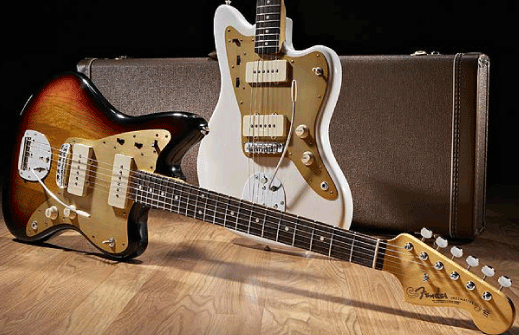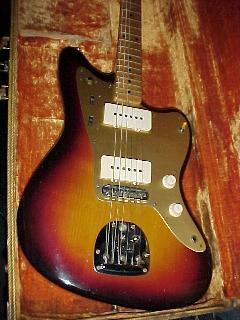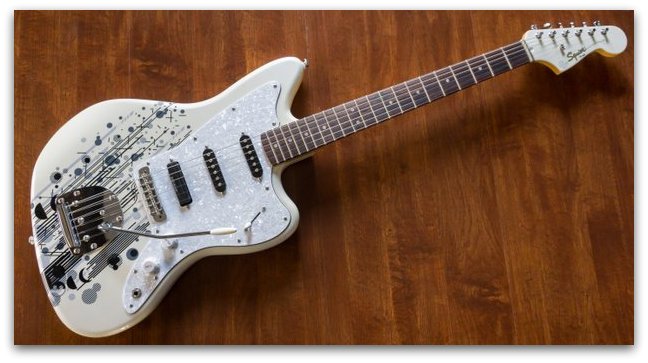 |
| 1958 Jazzmaster Ad and 1962 Jaguar Ad |
By 1958 Fender had come up with a whole new concept that Leo Fender thought would replace the Stratocaster. In his ever improving style, Leo Fender had created an offset body design for the Fender Jazzmaster and it could be a rhythm instrument or a lead instrument by merely flipping a switch.
This guitar came with a back contour similar to the Stratocaster, but the offset body design he applied to the Jazzmaster meant that the upper and lower halves of the body are offset from each other to provide added comfort for the player.
Essentially, the body of the instrument leans forward. The Jazzmaster featured an offset body and waist.
Prototypes of the Jazzmaster existed as early as 1957, but the guitar was finally offered to the public by August of the following year.
The initial models had aluminum anodized gold pickguards as shielding. That idea was scrapped in 1959 in favor of faux tortoiseshell nitrate celluloid pickguards.
The Jazzmaster was equipped with newly designed pickups that were wide and flat and covered in a larger rectangular housing.
The intent was to pick up a wider area of the string thus producing a larger and mellower sound. Who knows? Perhaps a secondary intent was to offer pickups that resembled Gibson’s P-90, which were popular at the time of the Jazzmasters introduction, although the design of this pickup is nothing like the P-90. The hope was to attract jazz players to use a Fender guitar.
 |
| 7-pole pickups and 1st version headstock |
However some early production and prototype examples came with a one-piece maple neck, others with an ebony fingerboard and/or a black painted aluminum pickguard.
 |
| George Fullerton's Prototype Jazzmaster |
 |
| 1959 Jazzmaster 2 tone sunburst |
 |
| 1965 Jazzmaster |
 |
| 1966 Jazzmaster |
 |
| 1965 Blond Jazzmaster |
Originally the Jazzmaster colours were offered in Fiesta Red, Blond, Metallic Gold, San Marino Blue, and some of the other 1950’s custom colours. You can bank on the fact that Blond Jazzmasters always has ash bodies.
 |
| 1958 vs 1959 upper bout routing |
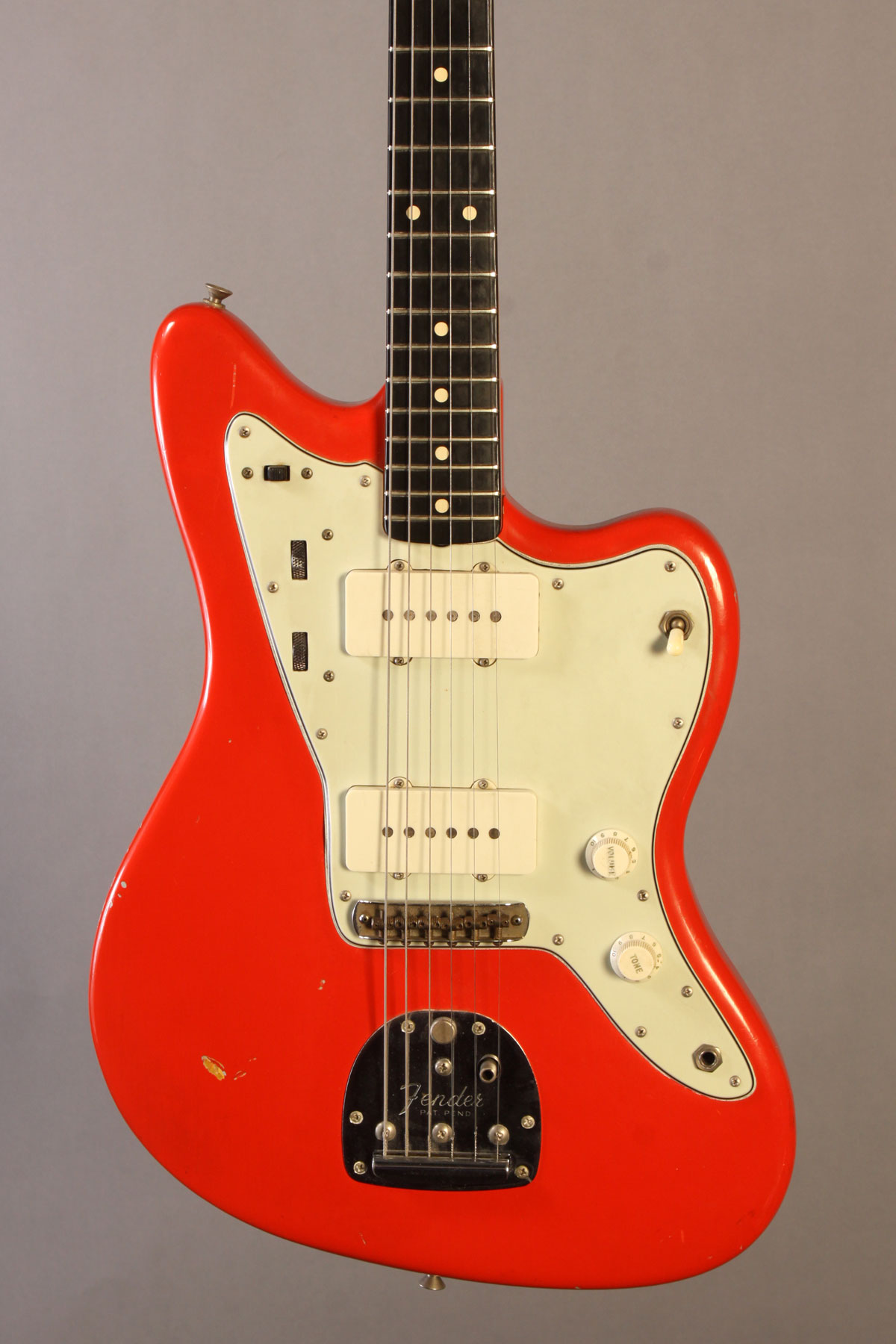 |
| 1957 Fender Jazzmaster |
So he decided the Jazzmaster would have two separate circuits for rhythm and lead work, so that the player could preset the tone and volume for rhythm work and with the flip of a switch instantly change the sound colour and volume of the guitar to loud and bright for lead solos work.
 |
| The Rhythm Circuit |
 |
| The Lead Circuit |
The 3-way throw toggle switch on the lower bout activates the neck pickup, both pickups or the bridge pickup alone. Tone and volume are controlled for both pickups through the more conventional potentiometers housed on the bottom lower bout.
As I already stated, the Jazzmaster comes with single coil pickups, which are encased in a brass shielded cavity and the bottom of the pickguard has an aluminum coating. This helps to cut down on hum, plus the two pickups have mirrored wiring which makes them hum-cancelling when both are turned on.
Despite the guitars name, it was never popular with jazz players.
Leo Fender also designed a new vibrato system for the Jazzmaster that he called a floating tremolo and bridge. This vibrato system include a locking mechanism or Trem-lock as it is called. The systerm worked by attaching the strings and the tremolo arm to a metal plate.
The inner workings are housed underneath in a routed out area within the guitars body. There is a screw in the middle of the plate to adjust the tension of the spring that is underneath the plate. The bridge that came with the Jazzmaster was designed to rock back and forth.
When the arm is moved up and down theoretically the string should stay in tune, but that is not always the case.
Remember this is the Jazzmaster and was designed for jazz players that were used to using medium to heavy gauge flat-wound strings. The instruction book that comes with the guitar suggest using .11 gauge strings. This size and tension of string seems to stabilize the tremolo better to maintain tonality.
The tremolo system is called a “floating vibrato” for its ability to vary pitch up and down since there is nothing resting against the body, like the block in the Stratocaster. Because of the dependence on the strings, if a string breaks it could effect tonality of the other strings. To avoid this the Trem-lock can be engaged by sliding it into place. Though it does lock your tremolo from raising the pitch, it also restores tuning.
I am told that tremolos on vintage Jazzmasters work better since they have stronger springs than current models.
The Jazzmaster was offered in the Fender line up through 1980. It was reintroduced four years later at a time when Fender had no production facility in the United States. The “62” Jazzmaster was made in Japan in 1984. The American Series Jazzmaster was made available in 1999.
 |
| 1962 Jaguar |
 |
| 1962 Jaguar |
 |
| Shielding in body |
 |
| Rhythm Circuit |
Instead of the controls being mounted directly on the pickguard, they were mounted on a chromed face plate. When disengaged, the lead circuit was activated.
 |
| Lead Circuit |
The center switch activated the bridge pickup and the third switch engaged an extra capacitor that cut the bass response. This gave the guitar a brighter tone for lead lines. Additionally the usual volume and tone knobs were mounted on a chrome plate below the instruments bridge.
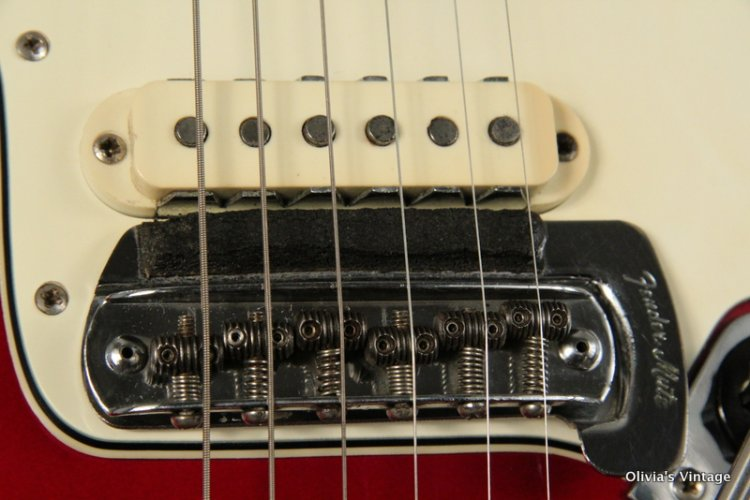 |
| String Mute |
 |
| Jaguar with bridge cover |
The tremolo system was spot-on the Jazzmasters system. The 1962 model was offered with a two tone sunburst finish. The 1962 model was actually introduced as early as December of 1960.
Most vintage guitar authorities date the introduction to 1962 when Fender ran an advertisement featuring a Jaguar automobile in the background announcing that Fender had introduced a new Jaguar.
The early ads for the Jaguar featured bikini clad young girls on sandy beaches. Perhaps this underscored the guitars appeal to surf music. It probably helped that Carl Wilson of the Beach Boys was provided with a white Jaguar, which showed up in promotional photos, concerts and on television shows.
 |
| 1963 Jaguar with mute intact |
 |
| 1965 Jaguar |
 |
| 1965 Jaguar - 3 layer pickguard |
 |
| 1966 Jaguar - bound neck/dot markers |
 |
| 1966 Jaguar - trapezoidal markers |
By 1968 the company had switched from using the more expensive nitrocellulose finishes to polyester finishes.
 |
| 1969 Custom Colours |
By 1969 Fender was seeing a decline in sales of the Jazzmaster and Jaguar and an up-tic in Stratocaster sales. Much of this could be attributed to the popularity of Jimmy Hendrix.
 |
| 1974 Jaguar |
This allowed the desirability to equally diminish, so used instruments could be purchased at bargain prices in the 1980’s and early’90’s. Punk and Indie band members saw these as way to buy a nice guitar on the cheap.
 |
| 1987 MIJ Fender Jaguar |
As the popularity swung back around, Fender saw the light and reissued the Jaguar as early as 1986/87 for the Japanese market. The body was unusual since it was not as contoured.
 |
| 1999 MIJ '62 Jag |
In 1999 the Fender Jaguar was being made in Japan for export to the US market. As I have mentioned in the past, Fender did not have a United States based factory at the time Bill Schultz and his associates purchased (rescued) the company from CBS. The first model produced was a 1962 version without the string mute.
 |
| '66 MIJ Jaguar reissue |
Enventually a '66 MIJ model was introduced with a bound fret board and trapezoidal position markers
 |
| 2007 Fender USA Jaguar |
American models use higher quality chrome rather than stainless steel parts and have brass shielding plates installed in the cavities.
Though Japanese guitars made before 1996-97 do also come with brass shielding. Additionally American Jaguars use nitrocellulose lacquer instead of polyester finishes.
 |
| Current USA Model |
 |
| Squier Vintage Modified |
The body is made of basswood, and it comes with stacked concentric controls.
 |
| Squier VM Jaguar |
 |
| Kurt Cobain Jaguar |
It features DiMarzio humbucking pickups, Gotoh tuners and a Tune-O-Matic bridge plus a modified wiring combination. It is offered as either a left or right handed model.
 |
| Johnny Marr Jaguar |
 |
| Johnny Marr Jaguar |
(Many guitarists use a Mustang bridge and saddle as it provides better tonality on a Jaguar or a Jazzmaster than the standard bridge/saddle unit.) This model uses a modified Stay-trem vibrato arm that holds the bar in one place. This model forgoes the standard lead circuit wiring in favor of a 3 way toggle switch similar to the one on a Telecaster.
 |
| 50th Anniversary Models |
 |
| 2007 J. Macics Jazzmaster |
 |
| 2008 Elvis Costello Jag |
 |
| 2009 Thurston Moore and Lee Renaldo Jazzmasters |
 |
| 2014 Jim Root Jazzmaster |
 |
| Troy Leeuwen Jazzmaster |
As of 2015 Fender offers a hardtail model of the Jazzmaster.
Squier offers several models including the J. Mascis signature Jazzmaster and the Vintage Modified Jazzmaster.
Additionally Squier offers a Vintage Modified Baritone version of the Jazzmaster with block inlays a bound neck and no tremolo.
Squire of Japan offers a version of the Jazzmaster, named for Mami Saazaki of the Japanese band, Scandal.
In 2012 Fender offered a limited edition Thinline Jaguar in black or sunburst.
s

